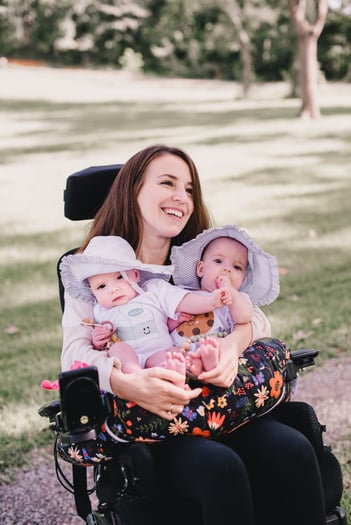The field trip to the museum was meant to inspire the recently injured patients from the rehabilitation hospital.
But for Dani Izzie—wearing a neck brace and using an unfamiliar power wheelchair– the art was all but invisible.
“All I could feel was how many people were staring at us,” she says. “I wanted to go and hide.”

At the time, Izzie was 23-years old and struggling with the shock of a C5-C6 injury. A month before, she’d been a young woman building a life in Washington, D.C; a fall had instantly changed everything.
“When I woke up in the ICU after surgery, I had a breathing tube,” she says. “Not being able to move, not being able to talk to my family, that was traumatic. You don’t understand what’s happening to your body, and your body is such a big part of your identity.”
Losing her mobility fractured Izzie’s sense of self. She’d gone to boarding school as a teenager and frequently traveled to Italy to visit her mother’s family. While most of her classmates chose colleges in the United States, Izzie opted to study at John Cabot University in Rome.
“Before my injury, I was very adventurous,” she says. “I was used to a lot of freedom and movement and traveling and independence.”
Suddenly, that disappeared. Izzie moved home with her parents, but the space wasn’t designed to accommodate a wheelchair user. Stairs everywhere, including the full bathroom, prevented her from being able to move through the house independently. She slept on a hospital bed in the living room.
“I just felt trapped in there,” she says. “The emotional toll was worse than not being able to move.”
After a year marked by severe depression, Izzie realized something had to change.
“I had to get out,” she says. “I had to challenge myself. I had to practice independence. So, what I did was make a huge, drastic choice.”
She packed a suitcase and moved to California.
The seismic decision felt like a return to her old self. Izzie began an activity-based therapy program in San Diego, where she met people with spinal cord injuries from around the world. Finding that community, she says, was transformative.
“These were people all going through the same thing together,” she says. “Having that support was really helpful to me, especially from the women I met. We’d go out together to bars as a group of wheelchair users, and it felt really empowering. We had each other, and we weren’t alone.”
At the same time, Izzie learned to reckon with the logistics of her injury, from traveling by paratransit to cooking for herself to adapting to having caregivers.
“I wasn’t used to having someone up in my business and taking care of me,” she says. “I had to learn to look at it as the key to my independence –rather than dependence.”
After another year, Izzie intentionally uprooted her life again, moving five hours north for graduate school at California Polytechnic State University. With a full scholarship from Swim with Mike, a non-profit that helps physically challenged athletes to pursue advanced education, the former field hockey player studied English and disability studies.
The deep dive into the history of the disability movement, along with the confidence she’d gained in San Diego as part of a tight-knit community of wheelchair users, helped Izzie push her recovery forward. She learned to comfortably navigate life as one of the few students with a visible disability, became an advocate on the local disability commission, and even began to date again.
“I remember I was flirting, and I was like, “Oh, I’m flirting— and people are receptive!’” she says. “So that was a good sign.”
By 2016, she had graduated and returned to San Diego to work as Social Media Manager for Spinergy, a company whose products include wheelchair wheels. During a visit home to see her family, Izzie met her future husband, Rudy. They dated long distance for 10 months until she “took another plunge” and moved back east; four months later, they got engaged in Rome.
 Izzie’s recovery was fueled by her determination to not let fear hold her back. But after she and Rudy were married, she faced one of her hardest questions: whether to try to have a baby.
Izzie’s recovery was fueled by her determination to not let fear hold her back. But after she and Rudy were married, she faced one of her hardest questions: whether to try to have a baby.
"I wasn’t sure I could take care of a child,” she says. “I had a lot of fears.”
But, thinking of all she’d already faced, she wouldn’t let herself rule it out. After meeting with a high-risk doctor whose practice had delivered babies for a dozen women living with limited mobility, Izzie reassessed what was possible.
"It gave me hope,” she says.


 Izzie’s recovery was fueled by her determination to not let fear hold her back. But after she and Rudy were married, she faced one of her hardest questions: whether to try to have a baby.
Izzie’s recovery was fueled by her determination to not let fear hold her back. But after she and Rudy were married, she faced one of her hardest questions: whether to try to have a baby.